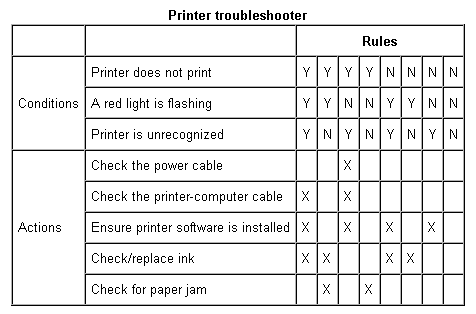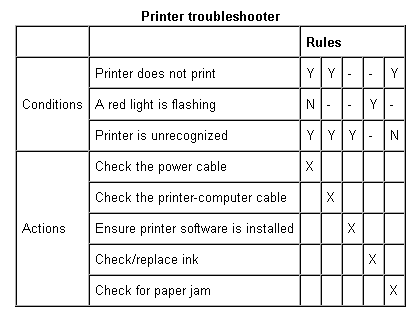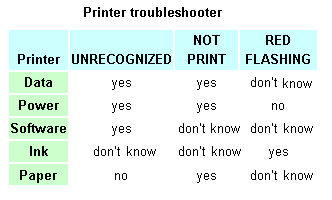Practical Applications
Robot Interface
One practical application may be in the interfacing of robots with humans.
Consider a sensor value as the value of an independent variable in a rule made up of the values of many sensors. In report and diagnostic mode it might be helpful for humans if the robot could verbalize its sensor status. The rule could be reduced to minimum form and provided to the operator as a summary of current sensor status.
For instance, when the rule above defining happiness is used as a template and "oil" is used in the place of "love" and "can move arm" used as the dependent event in place of "happiness", then, when the robot is asked to report when it can move its arm, as the dependent event inquiry the robot, recalling its status in summary for all occasions, would say, "Robot can move arm when lots of oil or some oil."
Admittedly crude but effective nonetheless.
Polychotomous Keys
While robots only need a decision table to provide cognitive functions and artificial neural networks to provide an artificial autonomic nervous system, humans require decision tables to be digested into polychotomous keys. Most professional disciplines, such as law and medicine, have actions and conditions, which can be stated in the form of a polychotomous key. The rules which link conditions to actions can be prepared for optimization by reduction to minimum form.
Developing a Polychotomous Key
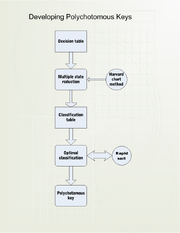
Steps in the development of a polychotomous key
Decision Table
Decision tables may have conditions with multi-valued states, where , in which equals the number of rules, equals the highest number of states, and equals the number of conditions. In the following example with two states and three conditions there are eight rules, . Each action may be associated with a rule by logical conjunction or logical disjunction. Actions associated by logical conjunction will follow the same rule, whereas actions associated by logical disjunction may follow rules whose conditions have ambiguous states in regard to a particular action.
In the example shown below the actions listed are associated by logical disjunction, and follow different rules.
Rule Reduction
Since the same action may be indicated by more than one rule as the result of ambiguous conditions the process of logical equation reduction can be used to consolidate those rules for each action with conditions, which have ambiguous states, resulting in a table with a single action per rule.
| Action | Rule |
| power cable | 1A0B1C |
| printer cable | 1A1C |
| software error | 1C |
| out of ink | 1B |
| paper jam | 1A0C |
Optimization
Ambiguous states may be redefined to eliminate any ambiguity and the order of the conditions optimized to produce the minimum number of queries.
| printer | not printing | red flashing | unrecognized |
| power | 1 | 0 | 1 |
| data | 1 | 2 | 1 |
| paper | 1 | 2 | 0 |
| ink | 2 | 1 | 2 |
| software | 2 | 2 | 1 |
0 = no
1 = yes
2 = don't care
The process of optimal classification will produce the following order which may not be completely intuitive.
A more intuitive order may be to ask first if the printer is printing, then if the red light is flashing, and then if the printer is unrecognized:
Polychotomous Key
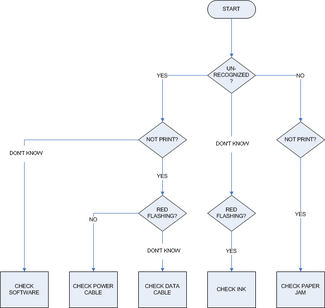 File:Arrowtotheleft.png75x50px
File:Arrowtotheleft.png75x50px 





